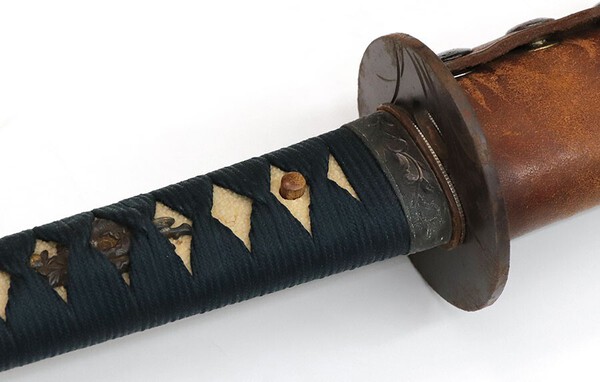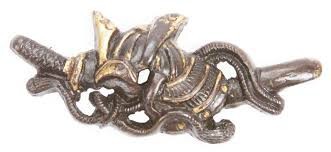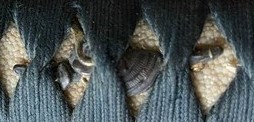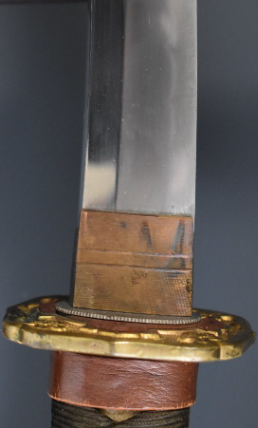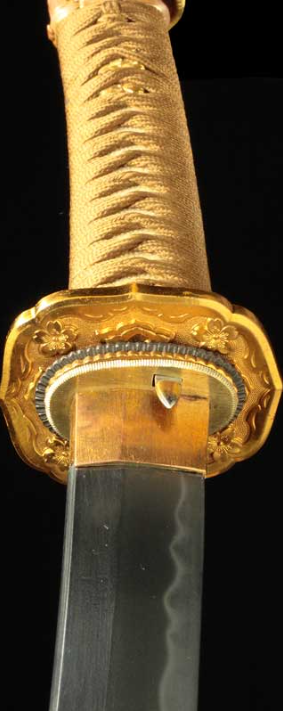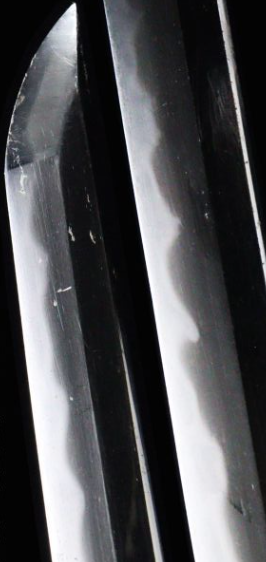-
Posts
897 -
Joined
-
Last visited
-
Days Won
12
Content Type
Profiles
Forums
Events
Store
Downloads
Gallery
Everything posted by mecox
-
I dont think you can assume a month, and so just list under the year, and if date is "Koki ni sen roku hyaku nen" then it is 2600 years (1940).
-
@John C John, here's some notes on "Empire" dates and months. Also in my paper in NMB Downloads of Taguchi Masatsugu (Hizen/Saga) at end are numerous examples he uses in this form.
-
Kirk, better to read this way, and summary from Sesko: KATSUMASA (勝正), Tottori – “Hōki Kanaya Katsumasa saku” (伯耆金谷勝正作), “Hōki-jū Kanaya Katsumasa kore o saku” (伯耆住金谷勝正作之), family name Kanaya (金谷), he also engraved a single coin crest onto his tangs, jōkō no retsu (Akihide), Second Seat at the 6th Shinsaku Nihontō Denrankai (新作日本刀 展覧会, 1941)
-
@John C John, as a matter of interest did you see my paper in Downlaods "Seki Toki Swordsmiths" it has an outline of Kanehide. Do you have these 2 oshigata from Fuller & Gregory 1983.
-
Nice work Jan, and interesting to see him in Sesko lists: NORIMASA (徳正), Keiō (慶応, 1865-1868), Hitachi – “Suifu-jū Inanobe Norimasa” (水府住稲延徳正), real name Kurosawa Sōjirō (黒沢宗次郎), student of Norikatsu (徳勝)
-
@Jake007 @Bruce Pennington Jake based on the nakago only and as noted above smith is Kaneomi and date November, 1943. But the blade almost looks chromed . But here is the smith: YOSHITOMI 義臣 (also read Yoshiomi): real name Takeyama Kazuo (武山数雄). Born Meiji 43 (1910) April 3, younger brother of Yoshinao (義尚). Registered in Seki on Showa 14 (1939) October 27 (age 29). Akihide 1942: Rōkō no retsu (7/7). Example mei: (“Seki Yoshiomi saku”), (“Seki ju Yoshitomi saku” SEKI) (“Takeyama Yoshitomi” SHO) [Slough p.202]. Your mei is 義臣 but interesting is that it has the small Nagoya Arsenal "na" 名 stamp on both sides. Note: I only later saw all the swords posted on this link !
-
@TastyReuben Patrick, interesting kaigunto by YOSHIAKI 義明: real name Mishina Naoichi (三品直市). Born Meiji 42 (1909) July 27. Registered as a Seki smith Showa 14 (1939) October 25 (age 30). In 1940 was a member of Seki Token Kaji Association. In Akihide Banzuke list of 1942 is rank of Ryōkō no retsu (7/7). He has examples with Sho stamp (no date) and Seki stamp (1941) with dragon horimono and bonji which is unusual in war period. Died Heisei 1 (1989) February 5 at age 70. Does not appear to work post-war. Example mei: (“Yoshiaki” SHO) (“Mishina Yoshiaki” SEKI), (“Yoshiaki” “1941” SEKI).
-
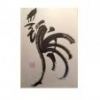
Help identifying sword taken to US after WW2
mecox replied to marked-content's topic in Military Swords of Japan
Mark, not much info found on 松田 兼高 ( note there are several other Kanetaka). He does not appear to have entered many exhibitions, and is not in the 1942 ranking. He was a senior smith in Seki. Born 1911 and independent (finished training) in 1930 is age 19. Seems this training was in the Nippon Tanren Juku and under Kojima Kanetoki (Kanemichi). Early registered in Seki in October 1939. So he would have been producing pre-war and the SHO stamps are from 1939? to 1942? Seki stamp is around 1943. He was a member of Seki Token Kaji Association ("swordsmiths") in 1940. Not found any info from late war, did he stop working for some reason? Here's some examples of yours: [1. Japanese Sword Index, Stein: SHO stamp] [2. Meirin Sangyo: Noshu Matsuda Kanetaka saku has SEKI stamp plus kokuin hot stamp, 68.4 cm / 1.6 cm ] [3. Ikeda Art: Matsuda Kanetaka 71.2 cm 1.8 cm SHO stamp long blade, may be custom] [4. Yahoo Auction: Noshu Seki ju Matsuda Kanetaka saku SHO stamp]. -

My recent purchase - SHIN GUNTO TYPE 98
mecox replied to Krzysio's topic in Military Swords of Japan
Kris, pic better this way. More on swordsmith (also see Naval Swords part 1 in NMB Downloads at top of page for examples) Looks to be well made and saya looks interesting custom work? Kanenaga, Amaike Ginjiro (包永天池 銀次郎) (older brother of Masatsune) born 4 September, 1884 (Showa 17), registered as Seki smith at Seki 15 June, 1941 (Showa 16) and living at Daimon-cho, Seki-machi. He may not have made (many) Navy swords. Kanenaga died March 8th 1958 (Showa 33, his posthumous Buddhist name was Enkaku Chikyō (円覚智鏡). Common mei: Nōshū Seki no jū Kanenaga kore saku (濃州関之住包永作之), Kanenaga (包永) -
Maybe , I think the whole mei and date are cut in a strange way. Earlier discussion on this went on for many posts.
-
@Matt Davis @Bruce Pennington As noted by Bruce looks like Kanesumi Sato sword dated as Showa 16 (1941). However, SEARCH this NMB for some other interesting discussion Kanesumi 兼住 Sato Kohachi 佐藤 幸八 (can also be read “Yukiya”) Born: Meiji 24 (1891) Oct 10 Reg. Registered as a Seki tosho: 1940, Dec 27. Address 1940: Kamo-gun, Kajita-mura. Became Rikugun Jumei Tosho Example mei: Kanesumi 兼住 (1943, Nov) Sato Kanesumi saku 佐藤兼住作 (Sho/sakura stamp) (also Tan stamp, another sword) Seki ju nin Sato Kanesumi saku kore 関住人佐藤兼住作之 Pics below: yours, Fuller & Gregory, Slough.
-
@Nicholas @Bruce Pennington about yasurime, as a rough idea from what i have seen for Kanefusa (23rd) its around 70% takanoha, 20% higaki (criss cross) and maybe 10% sujikai. However, some are poorly filed or bad pics which confused last two types.
-
@Slaborde samegawa/same is a ray/stingray and is good on yours. Later in war there was some use of early plastics in artifical material, and at end of war were using paper/tape/bark etc. Seeing you are chasing info look at following post. There is some terrific material in here, but second one is for you = Encyclopedia....and only $12.50, just what you need.
-
@Slaborde Sara here are some details from the example 6-7-8 I sent you. Your original tsuba could well have been in this style. Also note the menuki, although a different design (flowers) similar style to yours.
-
-
@Slaborde I would call your sword a katana made in WW2 or just before. I my opinion it did not have any gunto (that is "army-sword") fittings and the brass one you posted was added later as a swap. So yes it would look like the one you just posted. There is one bit missing on your saya (scabbard), which was a metal (or bone or wood) ring around the mouth of saya (Koi-guchi "carp mouth"). The original tsuba could have been oval shape iron (or copper) with a simple design of carving keeping with the fuchi-kashira. Others may comment.
-

Help identifying sword taken to US after WW2
mecox replied to marked-content's topic in Military Swords of Japan
Mark, good looking sword and in original state. A good smith from Seki working from pre-war. 兼高 Kanetaka (松田 高市 Matsuda Takaichi) Born: Meiji 44 (1911) September 16; registered as a Seki smith: Showa 14 (1939) October 26. Lived in 1937 at Bugi-gun, Seki-machi, Aza naka-machi. In 1939 at Seki-machi, Naka-machi. History: trained from Taisho 13 (1924) under Kojima Kanetoki (Kanemichi). Became independent (completed traing) Showa 5 (1930) May. Example mei: Kanetaka 兼高 Noshu Seki ju Matsuda Kanetaka saku 濃州関住松田兼高作 For context of his work see Downloads at top of NMB page and find paper on Gifu Swordsmiths -
@Slaborde Sara, have a look at this sword (Kanesada), as a coincidence he was brother of your man (kaneyoshi)
-
Bruce, maybe, but cant see marks of a suspension ring and still has kurikata. To me gunto tsuba is damaged, plus hole for spring clip and seppa are pop-outs. I think more likely someone pinched the tsuba that matched the fuchi-kashira and replaced with gunto. (Again an opinion!!).
-
Krzysio, need to see more of the blade and nakago (tang). Looks like saya has been repainted. But looks a nice sword to start. Here is the smith: 兼定 Kanesada (岡田 定男 Okada Sadao) Born: Meiji 38 (1905) Sept 9; Reg Showa 14 (1939) Oct 8. Died September 1, 1966, age 61. 1937: Bugi-gun, Seki-machi, Otsu 1921/2. 1939: Seki-machi, No-machi. Deshi in 1937: 0. History: trained as swordsmith from Showa 10 (1935) April under Okada Kaneyoshi . Summary: during the war was employed by Noshu Nipponto Tanrenjo. Brother of Okada Kaneyoshi. 1938: 3rd shinsakuto exhibition received Nyusen-sho. 1942: Tosho Banzuke 6th level of 7 (Chuge Saku) Example mei: Kanesada 兼定 Noshu Seki ju Okada Kanesada saku 濃州関住岡田兼定
-
@Slaborde @Bruce Pennington Sara well done with pics. Yes blade has a hamon, its not fully straight (suguha) but is slightly wavy, but hard to see. Looking at all your pics, my guess would be: a WW2 made sword by a good smith, and is a "Showato" (not traditionally made and not with tamahagane special iron) so would be oil tempered, but a well made example. Looks to have been mounted as a "samurai" katana, and may well have had a reasonable tsuba (guard) and someone has swapped it for a wartime gunto tsuba and cheap seppa (washers). It could have been a custom order as a katana, and could have had a leather cover on the saya (scabbard) and used by a civilian working with the military. Probably your dad got it like this, so is worth looking after. (do NOT use abrasives on blade or nakago (tang) over mei (signature). Follow what Bruce says.
-
@Slaborde @Bruce Pennington Sara and Bruce thanks for kashira pic, as best as I can see it matches the fuchi (but poor pic of tsuka). So it is a complete bound tsuka with fuchi-kashira and menuki. However, I dont think the shingunto tsuba is original. It has an offset hole for spring clip as with shingunto, but seppa are not matched and no hole. Such a koshirae more likely to have plain iron tsuba with bigger hole for leather strap (like example 6-7-8).
-
@Slaborde Sara, pic of sword (but still does not show kashira) and looks to me like its mounted for civilian working for Army. The detail of your tsuka shows menuki design of helmet/armour/tachi. The fuchi is not gunto. I wonder if gunto tsuba is added later and with spare seppa. The blade (and mounts) are similar to example #6,7, 8 posted above. But does not look would be carried by Army officer. Lets see other opinions.
-

Translation Assistance and Confirmation - Amachi Masatsune
mecox replied to tbonesullivan's topic in Translation Assistance
@tbonesullivan David, looks to be a good sword from a very good smith. From Sesko: “Masatsune” (正恒), real name Amachi Reiichirō (天地鈴市郎, first name also reads Suzuichirō), born. September 23rd 1894, he worked as guntō smith and died May 12th 1949, Fourth Seat at the 6th Shinsaku Nihontō Denrankai (新作日本刀展覧会, 1941). He was a Seki smith, born 1894 and who registered early in Seki on Showa 14 (1939) July 1. In NMB Downloads (top of page) my paper on Japanese Naval Swords part 1, has his background and quite a few examples. He was a key swordsmith. With Sho stamp your is early war. -
@Slaborde Sara, in the NMB Downloads look for the paper Japanese Swordsmiths Gifu 1937. This has a summary of your Okada Kaneyoshi which explains his background and the period and a pic. (Note that there are a number of "Kaneyoshi" but use different kanji). You will also find more info on NMB if you use the Search function (top right). It would be good to see a full pic of your sword to better understand what it is and timeframe. He looks to have been quite productive and also produced blades that were custom mounted. There is some variation in his work that indicates period of work. Here are some examples for study. (1) "Seki jū Okada Kaneyoshi saku" takanoha filing, bohi, no stamp [Slough p.74]. (2) (3) " Seki jū Okada Kaneyoshi" , sujikai filing, no stamp [Sara]. (4) (5) "Noshu Seki ju Okada Kaneyoshi saku kore" takanoha filing,,,nagasa 69.6 cm, sori 1.6 cm, bohi, choji-gunome-midare hamon no stamp [Meirin Sangyo]. (6) (7) (8) "Seki ju Okada Kaneyoshi saku" SEKI stamp, sujikai filing, nagasa 69.6 cm, sori 1.9 cm, gunome-midare hamon, custom "gunto" koshirae [Meirin Sangyo]. (9) "Okada Kaneyoshi saku" nagasa 64.0 cm, sori 1.6 cm, suguha-miadare hamon, shingunto leather saya cover. (10) (11) "Kaneyoshi" takanoha filing, nagasa 61.2 cm, sori 1.2 cm date: Showa 19 (1944). (12) (13) "Noshu Seki ju Okada Kaneyoshi saku kore" takanoha filing, bohi, no stamp, nagasa 66.2 cm, sori 1.6 cm, suguha? hamon, well made blade [nosyudo.jp]. (14) (15) "Noshu Seki ju Okada Kaneyoshi saku kore" takanoha filing, bohi, no stamp, nagasa 67.0 cm, sori 1.4 cm, choji-gunome-midare hamon [Meirin Sangyo]. (16) (17) "Noshu Seki ju Okada Kaneyoshi saku kore" takanoha filing no stamp, nagasa 66.4 cm, sori 1.3 cm, koshirae is custom Type 98 shingunto, hamon irregular gunome-choji [ Kurogane House}. (18) (19) "Seki ju Okada Kaneyoshi saku" takanoha filing, gunome-choji-midare hamon, no stamp [yahoo auctions.co.jp]







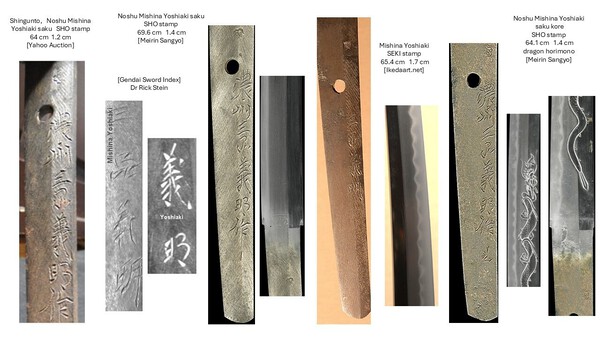





.jpg.100d309ae99885d0f310a7cbf44ca225.jpg)

